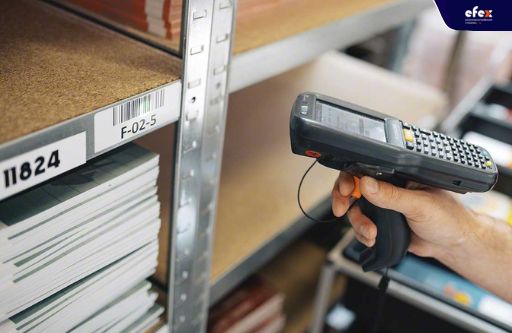
More Helpful Content
Item coding is a method used by most businesses to improve inventory management. The coding of items helps in improving the efficiency of the supply chain, and employees working in the warehouse also benefit from the convenience of sporting goods. At the same time, business owners also get the most detailed information about the status of their company's goods.
So, if you don't have an overview of item coding, read the article about the definition and benefits of item coding below.

Item coding is used to uniquely identify items that are in stock. Some businesses also call them “model number”, “part number”, “product number”, SKU, etc. Item coding has an important role in the management of goods. If your item system can't identify unique product information, you won't have enough data to evaluate how well that product is doing for your business.
Item numbers are also often used as an abbreviation to describe items with longer names. You can use a shorter number of rows instead of having to enter a detailed description for an item. This will help the process of data entry and inventory management be fast and efficient.
👉 Read More: Item Master: Example And Best Practices
As a manager, it is important that you apply every method to optimize inventory management. One of the ways used by many businesses is material coding. Encryption is a feature that has been used for a long time to help people identify items.

Some of the benefits below will help you understand what coding of items helps in:
👉 Read More: 13 Stages Of Procurement Cycle With Detail Instructor

Item coding can be done in a number of ways depending on the symbology used. Companies will choose which system suits them best by assessing the nature of their operations. The most common formula is:
When you want to deploy your own customized system, you need to make sure that the system is user-friendly and suitable for customers and employees. Codes should be short, easy to write, and easy to remember for ease of use. Once the encoding type has been selected, the next step is to label the item. This is where barcodes used in warehouses reach their full potential. The laser scanner will have the job of reading barcodes and converting them into alphanumeric equivalents. And then you have an efficient and accurate inventory management system.
Currently, there are many types of codes such as QR and RFID tags, but the most effective ones that many companies still use are barcodes. This is reflected in the popularity of barcodes in the logistics industry. Not only used in businesses but barcodes can also be used between businesses. But to do that will need standards that need to be passed. The International Society of Article Numbering or GS1 has developed a coding system to ensure product identification at an international level. These are the barcodes that business owners need to know. Some of the most iconic barcodes that this association has established are:
👉 Read More: 10 Steps Of The Procurement Cycle
The goal of item coding is to ensure that the item's location in the inventory and traceability are fully provided. Coding is also seen as organizing and controlling to improve inventory management. The biggest advantage of product encryption is that it gives users control over the movement of products in the supply chain. WMS has always been seen as a special support tool for managers in controlling inventory and all product movements in the supply chain. To do this, the combination of ERP and WMS is the most effective way.
Because then, the process will be operated as follows: ERP manages the overall data on each item and WMS will read the product and assign the appropriate location for that item in the warehouse. Companies need to identify all products as they arrive at the installation site in order to categorize them appropriately, according to their characteristics. WMS integration criteria for full stock in the warehouse. In real-time, this system knows the exact position of each object.

You shouldn't include leading zeros, because when importing item lists into your inventory system, you'll often be asked to upload a Microsoft Excel CSV file. Microsoft Excel usually removes the leading zero on all numbers, for example, "0987" will become "987". This will lead to a change in the code and cause errors in the management process.
Typically, the SKU code will have a minimum of 4 characters and a maximum of 12 characters. Longer product codes when printed out will lose codes, affecting inventory. Please name the code based on the characteristics of the product and have a reasonable length for easy writing and remembering.
You should change the product code instead of keeping the same manufacturer's code. This will ensure you have no supply chain disruption in the event of a double-code-named supplier. Using your own code will also make it easier for you and your staff to remember and use.
We recommend that you only use capitalization or symbols such as dashes (-) in product codes. Special characters can cause problems in synchronizing product codes in different sales channels. For example, Microsoft Excel will usually not accept special characters. You should choose familiar characters and try to create the simplest item code to make the data entry process smooth.
If you sell clothes, shoes, hats. All products in the clothing group will begin with "CLO" Shoe products will have a code that starts with "SHO" Products in the "Hats" group will begin with "HAT" If we have 10 different shirt colors, we can number them in order: CLO-01 CLO-02 CLO-03 With this scientific arrangement, the employee's lookup is faster and there will be fewer errors in product differentiation.
Dashes may be used cleverly to show product differences such as size or color. If we sell caps, we may start with "CAP" as the SKU foundation. Then we put a dash in there and a two-letter color code: CAP 01-RD - Red Hat CAP 01-BL - Blue Hat If feasible, limit color codes to two or three letters/numbers.
Establishing a consistent naming rule will help you handle sudden changes from the manufacturer. For example, if the supplier started stocking blue jeans in the "JEA01" design, you could easily add "JEA01-BL" as the new SKU. Note that if there is any change, it is necessary to notify the staff in the warehouse to avoid errors caused by mistakes.
👉 Read More: 10 Disadvantages And Advantages Of Activity-Based Costing
In conclusion, item coding is a key factor in creating a smooth and efficient supply chain. You will get a lot of benefits in both time and money if you apply the right coding of items in your business. Hope you have a good time with Efex.


